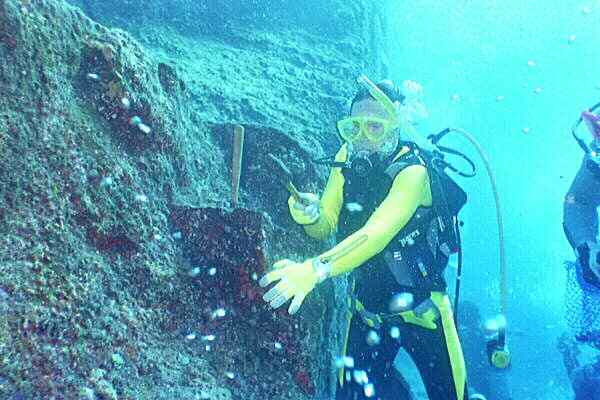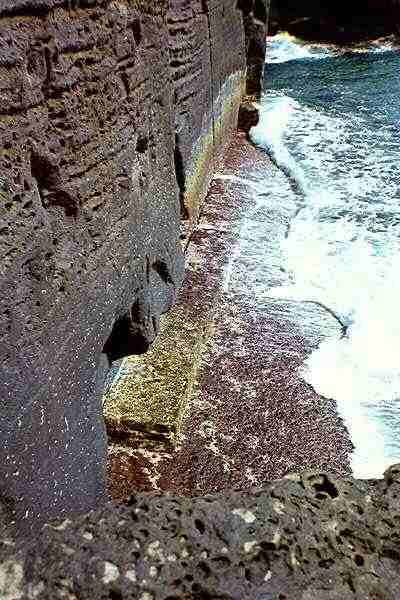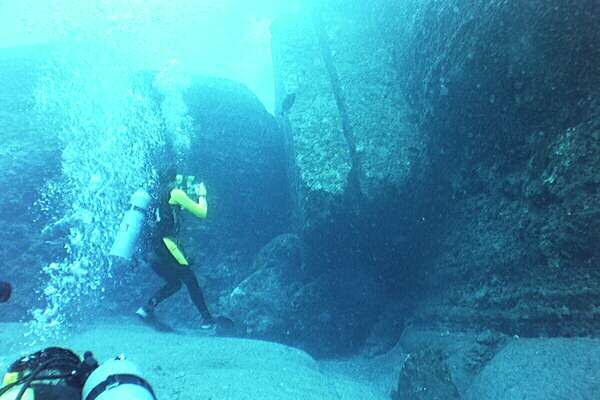![]()
![]()

text translation service for 25 worldwide languages
Dr
Robert M. Schoch continues his Yonaguni investigation …
During
my own research on the Yonaguni Monument, one of the first things I found
is that the structure is, as far as I could determine, composed entirely
of solid living bedrock.
No part of the monument is constructed of separate blocks of rock that
have been placed into position. This is an important point, for carved
and arranged rock blocks would definitively indicate a man-made origin
for the structure – yet I could find no such evidence.
During my
initial two dives of September 1997 I was unable to determine, even in a
general way, the stone of which the Yonaguni Monument is composed. This
was due to the fact that the surfaces of the rocks are covered by various
organisms (algae, corals, sponges, and so forth)
that obscure the actual surfaces. I believe that this coating of organic
material tends to make the surfaces of the Yonaguni Monument appear more
regular and homogeneous than they actually are. This, in part, enhances
the impression that this must be an artificial, man-made structure.
On
some of my later dives I spent time scraping the organisms off the rocks
in several places, so as to gain views of the actual rock faces, and also
brought some samples of the rock to the surface. The
Yonaguni Monument is composed predominantly of medium to very fine sandstones
and mudstones of the Lower Miocene Yaeyama Group (the
rocks themselves were deposited about 20 million years ago).
 |
These rocks contain numerous well-defined, parallel bedding planes along which the layers easily separate.
The rocks of this group are also criss-crossed by numerous sets of parallel and vertical (relative to the horizontal bedding planes of the rocks) joints and fractures. Yonaguni lies in an earthquake-prone region; such earthquakes tend to fracture the rocks in a regular manner. |
Copyright 1999 Robert M. Schoch.
The more
I compared the natural, but highly regular, weathering and erosional features
observed on the modern coast of the island with the structural characteristics
of the Yonaguni Monument, the more I became convinced that the Yonaguni
Monument is primarily the result of natural geological and geomorphological
processes at work.
On the surface I also found depressions and cavities forming naturally
that look exactly like the supposed post
holes that some researchers have noticed on the underwater
Yonaguni Monument. I have also spent a fair amount of time traveling the
length and breadth of Yonaguni Island so as to examine and gain an understanding
of the local geology and geomorphology of the island.
 |
Along the southeast and northeast coasts of Yonaguni Island the Yaeyama Group sandstones are abundantly exposed, and here I could observe them weathering and eroding under current conditions. I became convinced that presently, at the surface, natural wave and tidal action is responsible for eroding and removing the sandstones in such a way that very regular step-like and terrace-like structures remain.
|
Copyright 1999 Robert M. Schoch.
In fairness to Dr. Kimuras position, I must point out that he believes
that at least some of the surface features that I here interpret as the
result of natural weathering and erosion are either man-made or were modified
by humans. However, I could not find any surface evidence (such
as tool marks on the rock surfaces or carved blocks that had been moved
into place) that, in my opinion, would substantiate his contention
of artificiality.
Of course,
I have had only a very short time to search for such evidence, and just
because I did not find it does not mean it does not exist. However, at
this time based on my own findings and analysis, I cannot agree with Dr.
Kimuras conclusion that the Yonaguni Monument is primarily a man-made
structure.
My current working hypothesis is that the Yonaguni Monument is primarily
of natural origin; that is, its overall structure is the result
of natural geological and geomorphological processes. I think it should
be considered a primarily natural structure until more evidence is found
to the contrary. However, by no means do I feel that this is an absolutely
closed case. The question of its genesis – artificial versus natural – may not
be an all or nothing question.
 |
We should also consider the possibility that the Yonaguni Monument is fundamentally a natural structure that was utilized, enhanced, and modified by humans in ancient times. The Yonaguni Monument may even have been a quarry from which blocks were cut, utilizing natural bedding, joint, and fracture planes of the rock, and thence removed for the purpose of constructing other structures which are long since gone. |
Copyright 1999 Robert M. Schoch.
follow Robert Schoch’s continuing Yonaguni investigation on
further reading about the Yonaguni monument
and Ice Age civilisation …
Barot,
Trushar, 1998. “Divers find world’s oldest
building.” The Sunday Times, London, (26
April 1998), page 4.
Hancock,
Graham, and Faiia, Santha, 1998,
Heaven’s Mirror: Quest for the Lost Civilization” London:
Michael Joseph.
Joseph,
Frank, 1997, “Underwater City found near
Japan” Ancient America, vol. 3, #17 (March/April
1997), pp. 2-6.
Minamiyama,
Hiroshi, 1997, “Bottom of the Ocean Ooparts
[Out of Place Artifacts]“. Tokyo:
Futami Shobo, Publisher. 302 pages. ISBN 4-576-97087-9. [In Japanese.
The Yonaguni Monument and related structures
are discussed on pp. 11-46.]
Schoch,
Robert M., with McNally, Robert Aquinas 1999,
“Voices of the Rocks: A Scientist Looks at Catastrophes and Ancient
Civilizations” New York: Harmony, Crown Publishing Group, Random
(UK edtion) is now also available worldwide.
“Do
undersea relics near Okinawa offer proof of a sophisticated civilization
during the last ice age? Archeologists have long believed that civilization
as we define it — intelligent, tool-making, monument building, social
humans — began about 5,000 years ago. But submerged beneath the waves
near the Japanese island of Yonaguni is evidence that may well overturn
that long-held theory.
A small but persuasive number of scholars and scientists have long
thought that “advanced” societies
may have existed as long as 10,000 years ago. Their theories, however
well reasoned and defended, have been hamstrung by a lack of evidence.
But recent discoveries of man-made artifacts on the Pacific seafloor
may well prove to be the smoking gun that will propel this alternative
view of civilization to prominence”.
see
the evidence with ‘unique underwater footage’
of the Yonaguni monument
in the VHS video of the ‘History Channel’
July 2002 television programme
“Japan’s Mysterious Pyramids”
land discoveries news archive | underwater
discoveries news archive
please
take a look at our Yonaguni
books & videos page …
| skywatching |
new discoveries | marketspace
copyright
© 1996-2002 morien
institute
morien-institute.org
1996-2002
Pioden
Interactive